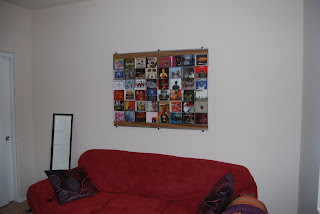






My latest project is a glulam style end table with square metal tubing legs. For those of you who don't know what glulam is, here's a link
Glulam is traditionally an engineered wood used for spanning great distances and is popular because it looks great and has great structural properties. BUT, glulam is also rising in popularity for tables and countertops
I like to combine wood with metal and stone or concrete because you can get a very modern look, (i.e. clean lines, sharp angles) using these materials.
This project was a learning experience. I went into it knowing what I wanted the table to look like as far as dimensions and style, but I wasn't exactly sure how to execute it.
Here's the basic idea: create a glulam end table top that is supported from the edge faces by 24" high aluminum square tubing. I wanted the table to have the effect of "floating" in between the aluminum legs.
The concept seemed simple: Cut 8-foot lengths of 2 x 4 redwood lumber into shorter 2-foot long pieces for a total of 11 pieces. Glue and screw those 2-foot sections together to make the tabletop you see above and sand the hell out of it with 80 grit, then 120 grit, then 220 grit, then stain with a medium walnut color stain, then varnish with a polyurethane top coat.
And then attach the legs. This part proved a little more difficult. I decided to custom cut four 1/4" diameter threaded rods and drill holes through each piece of wood, then drill holes through the inside face of each piece of square metal tubing then somehow reach inside and thread on and tighten a nut to secure the legs from the inside.
You can see in the pictures above the threaded rods sticking out. I had to drill holes individually into each piece of wood, and then hoped I had been accurate enough for them all to line up so I could put the threaded rod through. That wasn't the case. The holes did not all line up so I had to pound the threaded rods through with a hammer and then use a hacksaw to cut off the ends of the rod to be the right length for attaching the legs.
Another problem I had was getting the table top to be completely flat. It ended up with a slight concavity, so when viewed in a plan view (straight on) it looks like it's "sagging" a little bit.
So there's the lengthy explanation of how I built the end table. Here's a step by step list of the supplies and order of operations to the project:
-Cut 2x4 x 8-foot redwood lumber into 2' sections
-Used hacksaw to cut a 1" wide x 96" long aluminum square tubing (from Crown Bolt) into 2-foot sections.
- Measured out where to drill holes for the threaded rod on one of my 2' redwood sections, then used that as a template to drill all the holes in each of the 11 pieces.
-Used wood screws to fasten all the sections together, starting with the middle two pieces and working my way out, making sure no screws were visible from either the top or outermost pieces of wood.
-Sanded, starting with 80 grit, then 120, then 220.
-Stained with a medium walnut color from Minwax.
-Coated with polyurethane clear semi-gloss, also from Minwax.
-Measured out and drilled holes for threaded rods into the INSIDE faces of the square metal tubing leg sections.
-Pounded the threaded rods through the table top and trimmed ends to size with a hacksaw.
-Fitted on the table legs, then carefully reached in and screwed on nuts to secure. Used wrenches to tighten down. I couldn't get nuts on the lower-most threaded rods because the ones above them were in the way. I predicted this, but didn't think that it would factor that much into the stability of the table. I was kind of wrong, as the table ended up a little bit wobbly.
- ended up getting some small L- brackets (also called corner brackets) and fastening them underneath the table top and into the inside of the legs for extra support and that did the trick and didn't take away too much from the aesthetics.You can see the L bracket sticking out a little bit in the side-view picture above.










